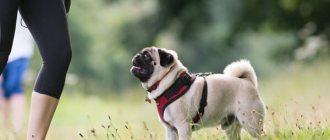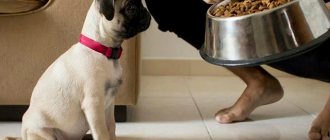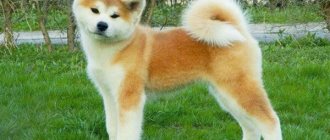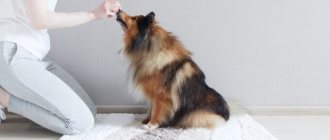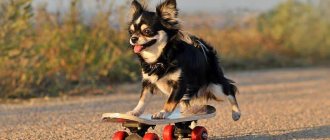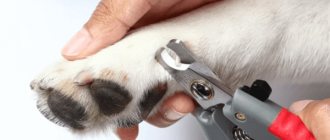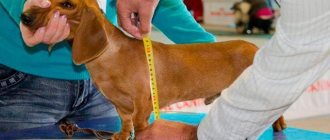Looking at a miniature dachshund puppy with short legs and large, deep eyes, you can’t tell that this breed was mainly bred for hunting. The breed's character retains hunting instincts, but despite this, the dog has perfectly adapted to life in an apartment. After bringing a pet of this breed into your home, it is important to remember that training your dachshund is very important. If you don’t start raising a puppy in infancy, it will try to subjugate its owner and will soon become the main dictator at home. How to properly train a dachshund, read our article.
Dachshund training: general rules and nuances
Basic qualities of the breed
There are many rumors surrounding the Dachshund breed. Perhaps the most famous myth concerns the character of the dog: it is believed that dachshunds are very angry and aggressive. In fact, a dachshund can only be aggressive if it was bought as an adult and was previously kept indoors.
Dachshunds in a 19th century drawing
Any owner, having bought a puppy, can raise a worthy and loyal dog with a little work. The character of the breed is characterized by such qualities as:
- friendliness. During a walk, she can rush to any passerby so that he can play with her and pet her. He loves to play with dogs of any breed, so it is important to ensure that the large dog does not injure the fragile bones of the dachshund during play;
- intelligence and learning ability. Representatives of the breed are very smart and quick-witted, they understand commands well and repeat them with accuracy;
- developed hunting instinct. They sense danger and perform well in hunting thanks to their primary instincts;
Dachshund is a burrowing dog
- determination. Natural instincts force the dachshund to go towards its goal without hesitation. She is able to climb a tree trunk for prey, like a cat. Despite its short legs and small stature, the dog can climb to any height.
A properly raised dachshund will become its owner's best friend and companion, especially if he has to hunt regularly.
Important! The main character traits begin to appear at 2-4 months, so at this time you need to give the puppy as much love and attention as possible. This will help the pet develop properly and avoid psychological problems and aggressiveness in the future.
Dachshund puppy
More about the breed
The first mentions of dachshunds date back to the era of Ancient Egypt - their images were found on ancient papyri. The breeding of dachshund puppies occurred thanks to the selection of short hounds - it was from them that an excellent sense of smell and the ability to pursue an animal during the hunt remained.
Advertising:
Obviously, these are hunting dogs that were bred to retrieve prey from holes. When hunting an otter, badger or beaver, there is no companion for the hunter more courageous and resourceful than them.
This breed is also famous for its quick wit and intelligence - this is not surprising, because in a narrow hole you have to rely only on your own abilities, you cannot count on the help of the owner.
Dachshunds are distinguished by their high intelligence
Mention of it as a modern breed dates back to the beginning of the 18th century - then they were still quite large and weighed about 20 kg. Later, smaller and smaller dachshund puppies began to be selected, thanks to which today representatives of this species are much smaller.
Standardization of the breed took place in 1879, and 9 years later its first club was created. Today these are small dogs with a lively disposition and a sharp mind, with a long body and short legs, which are famous as unsurpassed hunters of foxes, hares and badgers.
This breed is characterized by a verified rutting behavior of the listed species of animals, which often does not take such a dog seriously. Most often, the dog holds the prey in the hole until the hunter comes and opens the hole.
The Dachshund breed was originally bred for hunting.
General recommendations for training at home
There are a number of practical tips that experts recommend following if training a dachshund in a domestic environment:
- You need to start training as early as puppyhood. The likelihood that the owner’s efforts will be crowned with success will be much higher;
- You need to create a daily routine from the initial days of the baby’s birth. Walking, eating and sleeping occur at the same time every day. You cannot deviate from the schedule, as this will have a negative impact on discipline in general;
- the owner needs to be very patient, since the dachshund has to repeat repeated orders many times to confirm success. Regularity and the right approach to training are necessary;
- We must not forget that the dachshund is an animal, not a human child. Small animals live in the present and instincts, without thinking about the future;
- a dog is an animal accustomed to living in a pack, so the owner has to take on the role of leader. The role of the leader should be immediately defined so that the pet will no longer attempt to dominate;
- Dachshunds need regular physical activity; a half-hour walk will not be enough for them. Dachshunds need long walks and frequent walks, otherwise they will not have the opportunity to expend all their pent-up energy. In this case, behavior problems may begin;
Active dachshund on a walk
- Let's not forget about the amazing intelligence of the breed. Dachshunds are capable of skillfully manipulating their owner, so the owner always needs to be on guard and not show his weaknesses. Otherwise, the dog will remember them and will take advantage of it.
So, the owner during training must be patient, judicious and carry out the lessons in stages, allowing the puppy to clearly remember the commands. The owner needs to try to find a common language with the puppy, give him enough physical activity and not allow him to manipulate himself.
Training a dachshund puppy at home
Theoretical basis
The training of any hunting dog is adjusted taking into account the innate characteristics of the breed, the so-called unconditioned reflexes. In addition to the basic (food, sexual, defensive, etc.) reflexes, Dachshunds have the skill of searching for prey. The desire to pursue a scented animal is an unconditioned reflex that cannot be stopped or eradicated. The only alternative for owners who do not intend to hunt is to teach the ward to control his impulses.
Note! The dachshund is prone to running away (chasing), digging the ground, being partial to wild animals, outbursts of excitement, rolling around in the soil, foliage and other “fragrant sources” - all these “quirks” are explained by the unconditional hunting instinct.
Self-control is a conditioned reflex , as is the impeccable execution of commands. Training a dachshund puppy will be much easier if the trainer learns a few simple rules:
- First, the command, then the stimulus - “Sit” , a pause of 2-3 seconds, if necessary, pressing on the croup. The only exception is “Forward” - a slight jerk of the leash, “Forward”, a few steps in the direction of movement.
- Pronounce the command the same way. You need to choose “Fu” or “You can’t” , “Fetch” or “Bring” , “Face” or “Take”, “Quiet” or “Don’t bark”, etc.
- Any command is given only once! “Sit, please sit down, what did I say? Sit!" - unacceptable persuasion! If you have given an order, it must be carried out.
- This recommendation follows from the previous one - work with your dog on a leash , this way you can always correct the actions of your ward without voice accompaniment.
- One team at a time! “Yes, not Stand, but Sit!” – the puppy hears two different commands and, confused, does not carry out either of them.
- Praise your dog for its success as if it were in the Guinness Book of Records! The more sincere positive emotions come from you, the faster the conditioned reflex will take hold.
- During training, the presence of factors to which the dog reacts unconditionally is unacceptable. The male will not obey, smelling a bitch in heat. The dachshund will not follow commands when it sees a hole or a wild animal. The only exception is a food irritant; it can and should be used.
- One tasty treat, two praises . Do not reward the dog with food for every command completed; the pet must understand that obedience is a way to please the owner, and not to eat.
Trainability
Professor from Canada Stanley Koren (University of British Columbia) conducted more than one study to create a multifaceted “portrait” of dachshunds during training . He classified them as breeds with average learning abilities.
Stanley Coren and dogs
The scientist came up with the following theses:
- The dachshund will execute the spoken command in 50% of cases;
- To consolidate a new command, it must be repeated at least 25 times;
- the fastest and most productive training occurs on the training ground in the company of other dogs;
- Dachshunds who do not have mental disorders are able to remember commands for life;
- At the same time, dogs can sometimes be stubborn and not listen to the owner’s orders.
The controversial nature of the dachshund forces the owner to look for his own approach to each individual. Dogs of this breed cannot concentrate on performing one action for a long time and are often distracted during exercise. To awaken your pet's interest in training, you can choose your puppy's favorite toy, hide it and give it only after the next lesson.
Important! Even if the pet has mastered all the commands well, it is important to reinforce them with regular training throughout its life. Otherwise, the dachshund may become stubborn and, at the right moment, refuse to follow the owner’s orders.
A well-trained dog straightens and stretches its body at the command of its owner.
When should you start training?
You need to start raising and training your dachshund as early as possible. They say about dachshunds that if you miss the moment and do not educate the dog, the dog will educate its owner.
Dog trainers advise starting training of puppies of this breed almost from birth. Dachshunds are superior to other breeds in their intelligence, but they are difficult to train, so education and training should become an integral part of keeping a dog - you should not waste precious time and “let the puppy be a child.”
First steps in raising a dachshund puppy
In training a dachshund, preference is given not to training , but to proper upbringing. Training can be postponed for some period, since even adult dachshunds can easily learn commands, and training must begin from the first minutes of the puppy’s presence in the apartment. Smart dachshunds, without the firm hand of their owner, will quickly begin to feel free and behave as they wish. A disobedient and arrogant pet will bring a lot of problems.
The puppy must develop good behavior skills, which he must strictly follow.
An ill-mannered dachshund puppy can grow into an arrogant dog
Step 1. Place
The owner must allocate his own place to the puppy immediately after bringing him home. The baby, who has never found a place in the house, will find one on his own. It will be almost impossible to wean your dachshund from spending the night, for example, in armchairs or under the sofa.
When the puppy starts asking to go to bed with its owners or jump on the sofa/chair, you need to pick it up and take it to the bed/rug. Then say “place”.
Important! It is more convenient to practice this skill when the family sits down at the table - a puppy who begins to ask for food is told “place.” This solves several problems at once: the little dachshund stops begging, while at the same time learning the command and learning self-control.
Dachshund curled up on his rug
Step 2. Teaching the dog to respond to its name
A dachshund puppy can remember his name quite quickly. In order for him to quickly learn his nickname, training is carried out as follows:
- the owner takes the treat in his hand, stands at some distance from the puppy and gently calls him;
- after the pet runs up to the owner, you should praise him and feed him a treat;
- the owner takes the treat again, but goes into the next room and calls the puppy from there.
You need to call your dog calmly and affectionately, without raising your voice. If she does not respond to the call, you should repeat the nickname again in a more persistent and demanding tone.
Important! If during a lesson the puppy did something wrong or began to play naughty, you should not shout at him. You should pronounce the orders “fu” or “no” in a stern voice.
Teaching a dog to respond to its name
Step 3. Toilet training
Up to 3 months of age, a dachshund puppy can “do its business” in a diaper or in a litter box. Before starting toilet training , you should allocate your baby his own corner, where there will be a bowl, a bed and a tray/diaper. The principles of training will be as follows:
- the process of getting used to going to the toilet begins after the puppy is taken from its mother. It ends depending on the character of the pet: one puppy can get used to the tray after 3 months of training, and another after a year;
- Toilet training begins with observation. At first, the owner will have to watch the baby in order to send him to defecate in the right place in time;
- if the puppy has already made a couple of puddles on the floor and wiped them off with a rag, you should put it in the tray;
- A two-month-old puppy usually wants to go to the toilet 15-20 minutes after eating. You need to keep an eye on the baby, and when he starts looking for a suitable place, take him to the tray4
- From the initial attempts, the puppy may not understand what the owner is trying to achieve. The key here is to be persistent;
What does the owner want from me?
- After the first trips to the toilet, some of the “to-do” remains on the floor. You shouldn’t scold your baby for this: on the contrary, if he went where he needed to, be sure to praise him and give him a treat;
- If a small dachshund misses the tray, it is forbidden to scold it, much less poke it with its nose. This treatment can achieve the exact opposite effect.
When the puppy is already calmly “doing his business” in a diaper or in a tray, you can smoothly transfer the toilet from the house to the street. When purchasing an adult dachshund, you should immediately find out whether it is toilet trained. Teaching a puppy to go to the toilet is much easier than teaching a puppy to go to the toilet.
Tray training a dachshund
Some dog breeders, even before regular walks, accustom the puppy to the command “Walk!” It is combined with a toilet: the owner says the command “walk” and takes the puppy to the litter box. This will allow you to develop a reaction. So, some dogs can walk outside for a long time, but still not go to the toilet. And with such training, the dog immediately after the command “Walk!” will go about his business.
Important! It is unacceptable for an adult dog to go to the toilet at home: this has a bad effect on the emotional state of the pet. This feature is due to the fact that any dog strives to move the bed and the “dining area” away from the toilet as much as possible.
Is it possible to immediately train a puppy to use the toilet outside?
If the owner is categorically against the puppy going to the toilet at home, he can immediately start walking the puppy. However, before 4 months it is very difficult to train a dachshund to go to the toilet outside. Since small dachshunds defecate quite often, you will have to constantly monitor your puppy.
As soon as the owner notices that the baby intends to “do his business” at home, you need to say “ugh” to him and immediately go into the yard. When your puppy goes to the toilet outside the house, you should praise him and feed him a treat. Little by little the baby will get used to it and will ask to go outside.
Relieving yourself in the fresh air
Step 4. Collar and leash training
You should start putting a collar on your dachshund puppy at two months of age. He will try to free himself, get nervous and itch, but you should not indulge the puppy’s whims. Gradually he will get used to it and begin to take the equipment for granted. However, the collar and leash have their own requirements:
- the collar should be soft and comfortable, not rub or press anywhere;
- you need to choose a leash that is light and made of high-quality material;
- The carabiner should not be heavy, but should hold the collar firmly.
The best time to train a dog to use a collar is when the dachshund has already become a little accustomed to its new home and has stopped whining and looking for its mother in the corners. You can try putting a collar on your puppy so that he can walk around the house in it and get used to the new sensations.
Dachshunds on a leash
Dachshunds usually have trouble getting used to collars. To speed up and facilitate the process, you should slowly pull the leash toward you and treat your pet with his favorite treat. Gradually, walking on a leash will become commonplace. The choice of equipment often raises some questions among owners:
- Harness or collar? Some experts insist on purchasing a harness because of the specific build of dachshunds. The bones of dogs of this breed are quite vulnerable, especially in childhood, and the harness is able to distribute pressure throughout the entire bone structure without pressing on certain points. It is also forbidden to tighten the collar too much, and a small dog can throw off the spacious loop without any problems.
- Tape measure or leash? It is better to choose the second option, since dachshunds love to pull on the straps. When walking in a roulette, the animal constantly feels tension, and will consider this a normal state, moving further and further from the owner.
Important! If the puppy loves playing with a leash, you should immediately wean him off it with the orders “Ugh!” or “You can’t!” The dog needs to accept the fact that the leash is designed for control, not for play.
Dachshund on a harness
Step 5. Getting used to walking outside
You can go for walks only after your little dachshund has received all the required vaccinations. During the first exit, puppies, as a rule, are very scared, whine and ask to be held. The pet needs to be reassured, petted, and reassured that there is nothing scary around. The first walk should take place in a deserted, quiet place, so as not to traumatize the baby’s psyche with unnecessary sounds. Gradually, you can go to more lively places, and when the pet feels free on the street, you can begin to meet other dogs.
Dachshund puppy on the street for the first time
Step 6. Teaching your dachshund the rules of living next to a person
Dachshunds develop habitual behavioral skills very quickly. Representatives of the breed are very smart, they are able to quickly realize that living without rules is much more fun. Moreover, if the owner does not start the education process on time. The pet owner must replace his mother, that is, become an authority whom the puppy will listen to unquestioningly. Rules that a puppy needs to be taught as early as possible:
- at night you cannot run around the house, whine, or scratch at closed doors;
- things and furniture should not be chewed or torn with claws ;
- You cannot beg or steal food from the table.
Often, while their owners are sitting down at the table, dachshunds like to beg for food. At the same time, they whine pitifully and rest their front paws on the person’s knees. The dog must be weaned from this habit immediately. The easiest way to do this is to establish contact with the baby and establish mutual understanding.
Grown up dachshund puppy begging
A small dachshund definitely needs toys: an active dog must splash out its energy somewhere. But you can’t give a lot of toys at once, since the baby constantly needs new experiences. In addition, the baby is not able to concentrate on several objects at once.
Dachshund puppy chews shoes
At what age do you start training?
Puppy training must begin from the very first days
the presence of a dog in your home. Because already from infancy, the puppy must learn the rules of behavior in your house, what is allowed and what is forbidden, how to behave with all family members, even the smallest and oldest, what he can play with and what he can’t, where to go. toilet and much more.
And we are talking, first of all, about the proper upbringing of a dachshund puppy, and you can start training and learning commands when the puppy is completely comfortable in your home. As a rule, one week is enough. By this time, the puppy is already filled with curiosity and is diligently exploring the world around him. If, after this time, the puppy remains fearful and does not make contact well, then it is better to seek help from a dog handler-animal psychologist, because This behavior is not typical for puppies of this breed.
When can you start training with a dog handler?
The beginning of the puppy's training coincides with the time of the first exit to the street. When the first two vaccinations have already been done, the quarantine (lasts 7-14 days, depending on the vaccination) after them is over. It is not at all necessary to train your puppy only outside; the first sessions are best done at home, where there are fewer distractions.
Often new puppy owners worry that training from the first days will be excessively stressful for the dog. This is only possible if outdated, rigid methods are used, and with the right approach, training from the first days will, on the contrary, be very useful, since it allows you to immediately establish contact
with the puppy and build a trusting relationship.
You can start raising a puppy from the first days of its appearance in your home, and training and classes with a dog handler can begin simultaneously with the start of walks, when quarantine ends after the second vaccination.
Why you don't need to wait up to 6 months
You often hear that dachshunds, like other dogs, cannot be trained before 6 months, because training is stressful. This opinion remains from the times of outdated methods based on cruel coercion and intimidation of the dog. Unfortunately, there are still plenty of dog handlers using similar techniques today. But fortunately, science does not stand still and modern techniques make it possible to train a puppy from the first days in a new home. Therefore, you should not wait until your Dachshund puppy develops unwanted behavior; you can start training much earlier.
Step-by-step dachshund training
The sooner the owner starts raising a small dachshund, the better. When all the good behavior skills have been accepted and gradually put into practice, it is time to start training. The first year of a puppy's life is the most important. During this period, you need to surround him with love and care, and with your attitude, convince the baby that he is a full-fledged member of the family. The new “child” should feel safe next to the owner and accept him as a fair leader.
Table 1. Stages of training a puppy up to one year old by month
| Age | What happens to the dog | What should the owner do? |
| 1 month | The puppy strives to play, moves energetically, responds to sounds and gets acquainted with the world around him. | The owner’s task at this time is to protect the emotional state of the pet, prevent the appearance of negativity and aggression in his life |
| 2 months | A voice emerges, the baby tries to attract attention by barking loudly | A slightly older baby can now be separated from the nursing mother and taken away from her to another place |
| 2-3 months | The little dachshund shows interest in walks and checks the durability of the owners' things. If you don’t direct the energy of a growing dog into play, all the furniture will be damaged | You can start teaching the puppy simple commands - such as “come to me”, “stay”, “sit” and others. Training should be made as pleasant as possible for the baby: praise him and treat him more often. There is no need to force the baby to do what he does not want - training should take place naturally |
| 3-4 months | A leader wakes up in a small dachshund, the dog tries to take a dominant position | The owner needs to make it clear to the dog that it is the person who is the leader. There should be no hesitation or concessions, otherwise the pet will refuse to recognize the owner |
| 4-7 months | The puppy becomes more aware and actively explores the world outside the apartment | The time of daily walks gradually increases, the dog gets to know strangers and other dogs. It is important to teach the puppy not to be afraid of them and to show himself well on the street |
| 7-9 months | Character is formed, bitches and dogs exhibit different behavior. Males try to establish themselves in the position of leader and behave aggressively, while females begin their puberty phase and have their first estrus. | The decisive age when further relationships with a pet depend on the strength of character of the owner. Females at this time need to be protected from negativity so that their character does not become worse |
| 9-12 months | The character of dachshunds shows balance and calmness; they mature and become capable of serious training. | You can begin training with more complex commands, periodically repeating those already learned |
A growing baby needs to be protected from aggression and situations that could frighten the dog should be avoided. A puppy under one year old is very impressionable, so any stress can affect it and provide the dog with lifelong psychological trauma.
Long haired dachshund puppy
How to train a dog to be alone?
For any dog at a young age, the departure of its owner is a horror and a nightmare. Dachshunds are no exception.
They become very attached to “their person” and by the age of 6-7 months they can no longer imagine their existence without him, so every even short separation causes a storm of negative emotions in the dog. Howling, barking and chewed slippers are the least that a dachshund owner will see upon returning home if the dog is not taught to cope with separation.
In order for the dog to react correctly to the owner leaving the apartment/house, you need to follow some rules to teach it to remain alone:
- Before leaving and upon returning, you should not express emotions strongly. If you say goodbye to a dog for a long time, he will take it as a signal that his owner is abandoning him. But you can’t hide your absence either. The dog must get used to the sight of its owner leaving. When you return, you should not hug the dog. You can calmly pet her and go about your business as if nothing had happened.
- The dog should be taught that the owner will return. To do this, you can practice grooming: over the course of several days, get ready, get dressed, wave to the dog, go out the door and come back literally in a minute. This way the dog will understand that the person will definitely return.
- Train your dog to respond to a person leaving. To do this, you can get dressed for several days, say goodbye and not leave anywhere.
- A very important role in accustoming a dog to the care of its owner is played by the “shelter” - the “norm” that the dog will build in its place. There she can hide and calmly wait for her owner, feeling safe.
IMPORTANT!
Do not forget that the howling and barking that a dog makes when the owner is absent can be caused by third-party stimuli - sounds under the door, outside the window, or other animals. Therefore, you should not scold your dog for the sounds it makes.
Raising a dachshund at an early age: important nuances
Puppy age is good for learning the first and simplest commands. The lesson lasts from a few minutes to 15 minutes a day, so as not to overwork the dog too much. When training capricious kids, you need to be guided by the following principles:
- Babies are very stubborn, so the owner needs to be patient. Getting used to each command will take some time;
The owner needs to be patient
- the command must be repeated several times in a row so that the puppy understands what the owner wants from him;
- During the first lessons, the dog is assigned a nickname. However, you cannot say her name in an abusive tone if you need to punish the puppy for an offense, otherwise the nickname will begin to be associated with something bad;
- the orders pronounced by the owner must be clear, loud and precise, without adding any words;
- small dachshunds can be very biting, for them it is an element of play. It is necessary to immediately wean off the habit of biting a person by replacing the hand with several toys. The process can be very complex, requiring repetition and persistence;
- you need to punish a small dachshund with the words “Place! ", "Badly!" or “You can’t!”, especially if she starts gnawing on her owner’s things.
Dachshund on a walk
How to stop chewing things?
A well-honed command “No” or “Fu”, pronounced in a confident tone, stops any attempts by the dog to chew on everything.
If the command has no effect, you can grab the dog by the skin at the withers and shake it. Of course, this method can only be used in extreme cases , when the dog does not respond at all to the owner’s commands.
Training puppies up to 5 months: basic commands
A four-legged pet under 5 months of age cannot yet go outside until fully vaccinated. However, there is no need to waste time. When the four-legged animal has already mastered the most important skills of living with humans, gradual learning of commands at home begins. At the initial stages there should not be too many of them, but orders need to be clearly rehearsed. The main commands are presented in Table 2.
Table 2. Basic commands that the dachshund should begin to learn at an early age
| Team | Learning algorithm |
| "To me" | When this command is pronounced, the puppy must immediately go to the owner. You can train it at home without a leash, giving the puppy a treat after performing it correctly. If the dog refuses to follow the command, the owner can pretend that he is leaving: the devoted baby will certainly run after him. Then he needs to be praised, after repeating the command. |
| “Ugh”, “No way” | A particularly important command, since puppies are very curious creatures who constantly strive to chew something or steal something from the table. If you try to do something like this, you need to sternly say “ugh” to the dog and lightly spank it. |
| "Show your teeth" | Relevant if the dachshund is going to participate in exhibitions and dog shows. This skill will also make regular dental cleanings and veterinary checkups easier. To teach this command, you need to sit the puppy on the left side of the owner, say the command, then squeeze his jaw with both hands and part his lips. With frequent repetition, the dog will get used to it, and the procedure will no longer be unpleasant. |
| "Sit" | To teach your puppy the “sit” command, you should take a treat in your hand and raise it above your pet’s face. The puppy will have to crouch to reach the treat. If this technique fails, you can, when raising your hand, lightly press the dog’s rear with your other hand. After completing the command, praise and give a “yummy treat”. |
| "Lie" | The owner also takes the treat in his hand, but now he does not raise it, but lowers it. The dog has to lie down after the treat. She should remain in this position for several seconds, and only then can she praise the animal. |
| "Give me your paw" | This is both a trick and a functional command that will make nail trimming easier in the future. The owner should hold the treat in his hand, hand it to the puppy and let him sniff it. After some hesitation, the dog will hit your fist, after which you need to say a command and give the puppy a treat. |
Practicing the command “Show your teeth”
What commands can you teach a dachshund?
Teaching a dachshund basic commands independently includes mastering the following actions:
- "To me!".
- "Stand!".
- "Sit!".
- "Place!".
- “You can’t”, “Ugh!”
But this is not a complete list of what a dachshund is trained to do. If desired, you can teach your pet more complex actions.
Training puppies from 5 months
5 months is the time when walking becomes very active and it’s time to train outside. Learning commands while outside the home is much more difficult than in the dog’s usual environment. Experts recommend before starting training to carry out a small procedure that will set the dog up for training. It could be your favorite game or something else.
Choosing a toy for a puppy
You should also come up with a command that will signal the start of the lesson. Many trainers use the phrase “Let’s get to work” for this. After this, all the exercises that were previously studied at home are practiced. After the baby has successfully demonstrated all the commands already learned, it’s time to learn new ones. They train first on a leash, and then without it. These are the commands:
- "Near!". The puppy walks near the person’s left leg, when the owner stops, the pet stands next to him;
Practicing the command “Near!”
- “Come to me, next to me!” The dog approaches the owner, goes around him and sits down on the left near the leg. The puppy remembers the algorithm with the help of a leash and a toy: the owner pulls the dog by the strap and holds a luring toy in his right hand;
- "Sit!" , "Lie!" . Commands are practiced near the owner’s left leg, using a voice command along with a toy or treat during the lesson;
Practicing the “Sit” command
- "Stand!". A command that can have multiple meanings. For example, if your dog often runs away while walking, it is recommended to learn a stopping command with it. Many breeders automatically yell “stop” to a running dog. Experts recommend using the command in a static form - “stand”. Such orders are processed 100% more efficiently than dynamic ones;
- "Place!" . On the street, this command involves returning to the original place where the dog was. She sits or lies down on the platform, and a toy or leash is placed next to her. Having moved a short distance, the owner calls the dog, after which he sends it back with the command “Place!”;
Practicing the “Place” command
- If the previous command has been learned, you can begin to master the “Guard!” command. It is combined with the “place” command: the owner puts some thing next to the dog, after which he says “place, guard” and leaves;
- “Crawl!” The dog is encouraged to act by pulling on the leash. With your other hand, you can lure your pet towards you with a toy or treat.
Practicing the command “Crawl!”
Initially, the puppy may perceive even familiar commands with misunderstanding, and this is in the order of things. The situation has completely changed, a lot of interesting things have appeared around, and the puppy doesn’t want to obey orders at all. In this case, the owner should be patient.
It is worth letting the puppy play, run around with other dogs, and only then start training. Until the puppy is sufficiently tired, there is no point in starting training: he will constantly be distracted by external stimuli.
Important! You should not pester your puppy with commands if he is very interested in something - he was staring at a passing cat, chasing a bird, or decided to chat with a neighbor’s dog.
The dachshund carefully waits for his owner's instructions
Accustoming to a nickname
A dachshund puppy quickly remembers its name. To speed up this process as much as possible, you will need the following:
- The owner takes the treat, takes a position at a short distance from the dog and affectionately calls it by name.
- When the puppy runs up, you need to praise him and give him a treat.
- The procedure is repeated, but each time the distance increases. Now you need to call the dog from the next room.
On a note! The dog is called in a gentle and calm voice. If the pet does not respond, you need to call him again, but more persistently.
Dachshunds quickly remember nicknames
Training an adult dachshund
If kids can be trained through play, then for adult dachshunds the learning process will be completely different. There are two methods of influence for them:
- Encouragement. This is done by voice, treats, stroking or light pats on the back. It is not recommended to stroke the animal’s head, and the dog should perceive patting as additional encouragement for verbal praise.
- Punishment. To punish a pet, you need to strictly tell him “no”, without repeating the baby’s name in the process. If obedience to the order is not followed, you need to lightly shake the pet, holding it by the collar, and then release it. Hitting a dog, choking it with a strap, or bullying it in other ways is strictly prohibited. If you feel that the training is not going as it should, you should simply stop training and When using vocal encouragement, you should say pleasant words with a balanced intonation, and if the owner wants to praise the dog more emotionally, you should move this procedure to the end of the training. It is important to end each session with positive moments so that the dog wants to train as much as possible.
You should only give treats during the training process and when learning new commands. It is better not to use treats outside of training: let them begin to be perceived as the result of successful work.
Important! The proportions in which rewards and punishments will be present during training depends only on the character of the pet. A diligent puppy should be praised more often for its successes, and a stubborn puppy should be punished more often.
On walks, a dachshund can carry quite heavy sticks
Differences in the education of males and females
Education depends on the animal’s character and habits. Dachshund training begins almost from birth. The main thing is to show who is boss in the house. If this is not done, the pet will not obey. You must be persistent and demanding, and avoid self-indulgence. Once a command is executed, the dog does not remember it for the rest of its life, so you need to train regularly.
There are significant differences in the education of males and females. Bitches during the birth of puppies are aggressive towards others, including their owners. You should treat this with understanding and refrain from punishment.
Expert opinion
Anna Abramenko
An avid dog lover. Experience in veterinary medicine since 2009.
Ask a Question
Puppies from birth and for several months must be surrounded by their own kind. You can’t immediately take them away from their mother. Otherwise, the dog will subsequently not be able to live among others like itself. Males will not pay attention to females in estrus, females will no longer allow males to approach them.
You should also be aware of the differences in behavior. Males protect their territory and explore the area. They are inquisitive, assertive, and independent. The main task of bitches is to reproduce offspring, this determines their cunning and sometimes resourcefulness. They follow commands, but if the dog doesn’t like the task, it will look for a way around it. At the same time, bitches are more affectionate and easier to train.
The main rules when training a dachshund
So, the main rules for training a dachshund, regardless of its age:
- A command should only be given if the owner is 100% sure that the dog is able to carry it out.
- The command is pronounced before the action. For example, you first need to say “Sit!”, and only after that press on the pet’s butt.
- Classes should be held on an empty stomach in between meals.
- Orders are voiced in a calm voice, clearly and identically at every training session. You can’t first say “Lie down!” and then “Get down!” or “Lie down!”
- You can only reward a completed command. You cannot praise your pet for an incorrect or incompletely completed exercise, this will only complicate subsequent training.
- There is no need to overload your pet by forcing him to learn several commands in one training session. Such activities will not bring pleasure to the puppy.
- Team "Ugh!" should be administered immediately after the puppy arrives. It should be used any time your puppy does something inappropriate, such as whining or scratching at doors.
Dachshund with his favorite toy
Thanks to the patience and perseverance of the owner, even the most wayward puppy can be raised into an obedient and devoted dog. It is important to remember that each individual has different potential, so you need to approach training individually.
Video - Training a dachshund at home
Behavior on the street
Walking for dachshunds is only available from the moment all vaccinations . To avoid a stressful situation, for the first walk it is better to choose a secluded place where the risk of meeting another four-legged animal is reduced to zero.
IMPORTANT!
During the first walk, the dog is always nervous and afraid. It is not uncommon for a dog to sit down, start whining, or ask to be held. The owner’s task is to calm the dog down with affection and instill a love for walks.
Types of sports with a dachshund
Representatives of the breed are very fast and agile; due to their small size and good running speed, they are able to easily cover long distances. Dachshunds can compete in speed races and take part in group competitions. The following sports are suitable for them:
- the dog can accompany the owner on bicycle rides;
- Flyball or obedience are suitable sports disciplines;
- representatives of the breed are excellent swimmers, exercises in the pool can be the most optimal for proper load distribution;
Dachshund swims in the pool
- Circus training is suitable, but stunts that are hazardous to health should be excluded from the program;
- Agility is also in fashion , where different breeds of dogs compete;
The representative of the breed needs physical activity: agility training
- Lure coursing is gaining popularity - sporting tracking of an animal, reminiscent of hunting: this can be interesting for a representative of the breed.
The last discipline is relevant for animals that have a very developed hunting instinct. For example, if during walks a pet chases cats and dogs, runs away from its owner and is unable to control itself, this activity is suitable for it.
Mining dog coursing
If a domestic dog is calm and balanced, you should not awaken its natural instincts on your own.
Important! When choosing a sport for your pet, you should avoid disciplines that place a lot of stress on the back. It is also not recommended to force dachshunds to jump over high barriers.
Care for claws and teeth
The nails of newborn puppies are trimmed so that they do not cause discomfort to the mother and do not accidentally injure littermates.
They are subsequently inspected and, if necessary, shortened. Particular attention is paid to the claws on the dewclaws, which may be on the forelimbs.
Changing teeth is accompanied by a constant desire to chew everything around. At this moment, bones are not given to the dachshund, but cartilage, carrots and a hard apple will save furniture and things from perforation.
Plaque in adult dogs is removed mechanically or ultrasonic. This is done by a veterinarian and often requires anesthesia or mild sedation.
Important: Ripe tomatoes are effective in fighting plaque. A small piece is rubbed over the stone 1-2 times a week. Tomato juice softens it and makes the dachshund's teeth whiter.
Mini-dachshund puppies: characteristics and approach to the dog
Among the already miniature representatives of the breed, there is a special variety - dwarf dachshunds. They are also called mini dachshunds. Despite their outward innocence, representatives of this species are no less stubborn than ordinary dachshunds, and therefore also require training.
The differences between mini-dachshund subtypes are striking
Owners who do not like excessive noise, as well as those who have children, are inclined to buy dwarf dachshunds. Mini-dachshunds are more balanced and calm. There are two subtypes of the breed:
Longhair
These dogs have long, wavy hair on their paws and ears, but the coat is not as shiny as other members of the breed. A parting is formed along the croup, and in some places the coat can be very short. They can be of different colors:
- with one color: fawn, yellow, reddish;
- with two colors: brown and tan, black and red;
- maur: dark stripes of fur are randomly located throughout the body.
The peculiarity of the breed is that long hair does not appear immediately. She grows only at one year of age. Long hair requires careful grooming, regular brushing and trimming.
The interdigital area on a dog’s paw requires special care: it needs to be trimmed at least once a month. The same procedure should be carried out in the groin area and on the ears so that the hair on these areas of the body does not roll off.
Longhaired dwarf dachshund puppy
Rules of care
A dachshund must have its own corner for sleeping and relaxing. Below we will talk about how to care for a dachshund puppy - this is very important so that it grows up healthy and joyful. There is nothing complicated in the rules on how to care for a dachshund - you will need ordinary care and attention:
- Daily walks in the fresh air are mandatory - your pet needs to move a lot and lead an active lifestyle;
- Caring for puppies of this breed involves purchasing toys and setting aside their own corner where they can relax or play with their treasures. If there are no toys, get ready for chewed-up shoes and furniture - horror stories are often told about puppies, but they happen to those owners who did not think to stock up on toys;
- Your pet should have a place to sleep - it should be a warm corner without drafts or excessive movement. Lay there a soft, cozy mattress with a removable cover.
- Don’t forget to comb it with a special rubber glove or brush;
- Caring for puppies of this breed does not involve washing them too often - this disrupts their natural skin acid-base balance. In the first six months, avoid swimming altogether - this is recommended by experts;
Don't forget to clean your dog's ears and teeth
- Trim your claws using a nail clipper - in adulthood, such dogs take care of their claws on their own, grinding them down;
- Clean your ears with cotton swabs soaked in hydrogen peroxide;
- Teeth cleaning is carried out with a special dog toothpaste with the taste of meat and a special toothbrush - this is necessary to avoid the appearance of tartar.
When and what to dress a dachshund
Smooth-haired dogs are dressed in overalls with insulation in severe frosts. A light blanket will protect your pet from the rain. The overalls can be replaced with a knitted sweater or soft jacket. They are sewn to individual measurements, since the breed has a non-standard physique.
If your dachshund has sore ears or are prone to inflammation, then you can’t do without a hat made from natural materials. The wool of such breeds as Caucasian Shepherd Dog, Keeshond, Japanese Spitz, St. Bernard, Moscow Watchdog and Collie is suitable.
In large cities, problems with reagents are common. They cause irritation of the skin on the paws, so boots are made for dachshunds from leather and special rubberized materials.

